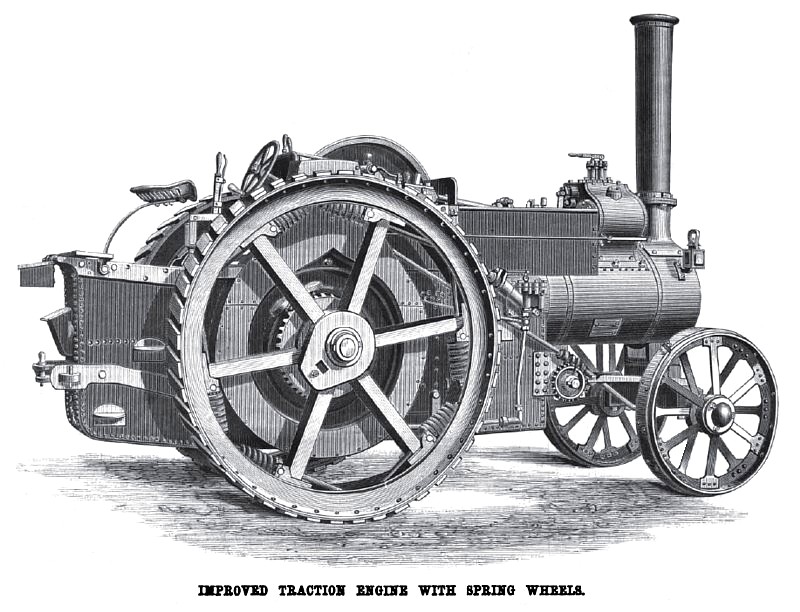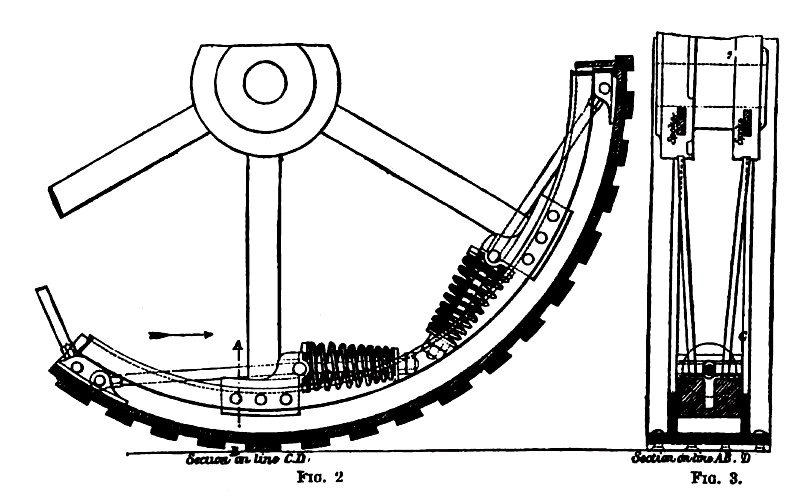|
Title: |
1884 Article-Aveling & Porter, Steam Traction Engine with Spring Wheels |
|
Source: |
Scientific American, V 50 #13, 29 Mar 1884, pg. 191 |
|
Insert Date: |
8/15/2013 7:41:25 PM |
TRACTION ENGINE WITH SPRING WHEELS.
The object of these, improvements is to provide the engines with means for relieving them from some of the shocks and strains to which they are subjected, particularly when working on hard and uneven roads.
Our engravings illustrate the latest improvements by Aveling & Porter, devised to give not only radial elasticity, but also a yielding in a circumferential direction, so as to enable the pull of the engine to be exerted through an elastic medium. The engine has been employed on the paved streets of the town and on country roads, and has run no less than 2,000 miles on these spring wheels, doing very heavy work most satisfactorily and without failure, so that the arrangement may be considered to have passed beyond the experimental stage.
We give from Engineering a perspective view of a six-horse road locomotive fitted with these wheels, and two sections of the wheels showing the details of their construction. In the case of the engine illustrated, the driving wheels are 7 feet in diameter, and the outer rim is, as shown in Fig. 3, composed of two T-iron rings of very substantial section, united by an external ring of plate iron 14 inches wide. The inner part of the wheel, on the other band, consists of a cast iron boss of the usual form, carrying six pairs of spokes, the outer ends of each pair of spokes being terminated by a east iron block cast on them. To these blocks are riveted two rings of flat bar iron, which serve to connect the outer ends of the six pairs of spokes as shown. The blocks at the outer ends of the spokes are of such dimensions that they, with their connecting rings, just work freely within the webs of the two T-iron rings of the outer tire, as represented in Pig. 3.
At three points in the inner circumference of the outer tire there are riveted to the latter pairs of angle irons, to which are jointed the links or bars on which the springs act. There are six of these links, which are coupled by pins to the three pairs of angle irons just mentioned, and each of which passes through the block at the end of the adjacent pair of spokes, and has threaded on it one of Timmis' helical springs, as shown. Each spring exerts its thrust on a base plate which is pivoted to the corresponding block at the end of the spokes, while the compression of each spring can be adjusted by means of the nuts at the end of the bar on which it is threaded. The whole arrangement, which is very simple and workmanlike, will be readily understood on examination of the perspective view of the engine and the sectional views of the wheel already referred to. We have had, says our contemporary, an opportunity of witnessing some interesting trials of the engine from which our perspective view has been prepared. As we have said, it is rated by Messrs. Aveling & Porter as a six-horse, and it weighs in working order a little over 10 tons. On the day to which we refer a trip was made with this engine and three traction wagons loaded with scrap iron, the three wagons with their contents weighing 28% tons, making the gross load, including engine, over 33% tons. With this load the engine was taken through the city of Rochester and up Star Hill—a hill which nature has kindly provided at a convenient distance from Messrs. Aveling & Porter's works, apparently to facilitate the testing of traction engines. This hill commences with a short gradient of 1 in 75, followed by 110 feet of 1 in 22, then 110 feet of 1 in 14, then 114 feet of 1 in 16, then 135 feet of 1 in 14, then 264 feet of 1 in 16, then 107 feet of 1 in 11, and finally 221 feet of 1 in 55. Altogether the hill is 1,137 feet in length, and rises 68 feet, giving an average gradient of almost exactly 1 in 18 ; but of the total rise 58 feet is effected in a distance of but 841 feet,- so that for this length the average gradient is 1 in 14%. Up this severe hill the engine took its load without hitch or trouble of any kind. Both when hauling this load up Star Hill and in passing over paved streets in Rochester, the action of the spring wheels was highly satisfactory.
On the return of the engine the wheels were severely tested by running the engine over timber laid across the road, "jumps" 8 inches to 9 inches high being thus repeatedly taken, and notwithstanding that the wheels after passing over the timber dropped the full height on the hard road, they sustained no injury whatever. Further experiments were then made to ascertain the extent to which the springs yielded under different conditions of working. For this purpose an iron pointer was securely clipped to one of the spokes and made to bear with its point on the web of one of the T-irons of the outer tire, so as to scratch on this web a diagram showing the amount of movement of the inner wheel within the outer tire. With the engine moving alone over a fairly good road it was found that this diagram showed a radial and circumferential elasticity of ½ inch, the curve traced by the point being almost a perfect circle. The engine was then coupled to one of Messrs. Aveling & Porter's 15 ton steam road rollers, and the brake of the latter was put hard on, while its engine was partially reversed so as to make the resistance just as much as the
traction engine could overcome. Under these circumstances the diagram traced on the outer tire became nearly triangular, the form being that of a triangle with curved sides, while the radial and circumferential elasticity increased to slightly over 1 inch.
Altogether, the action of Messrs. Aveling & Porter's spring wheels was throughout the experiments most satisfactory in every way, and the arrangement is one well fulfilling the requirements of the problem to be dealt with. One special feature in the wheels worth notice is the ease with which the springs can be adjusted so as to put them in a greater or less state of compression—thus making the whole wheel more or less rigid, as may be desired. |
|
 1884 Aveling & Porter, Steam Traction Engine with Spring Wheels
1884 Aveling & Porter, Steam Traction Engine with Spring Wheels
 1884 Aveling & Porter, Spring Wheel for Steam Traction Engine
1884 Aveling & Porter, Spring Wheel for Steam Traction Engine
|
|